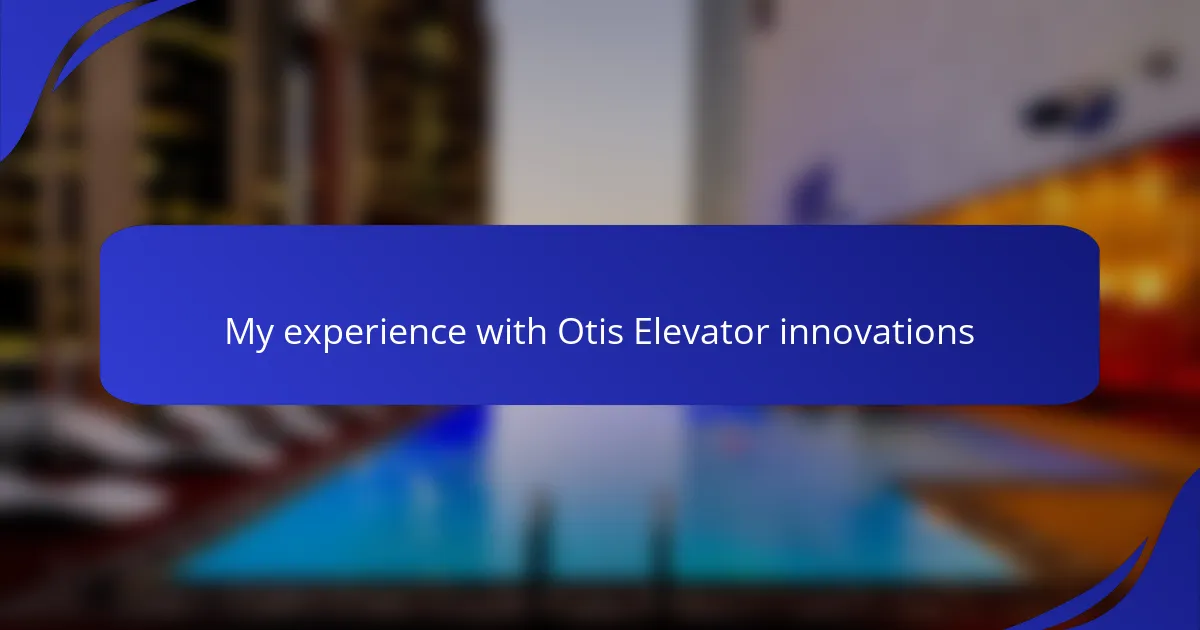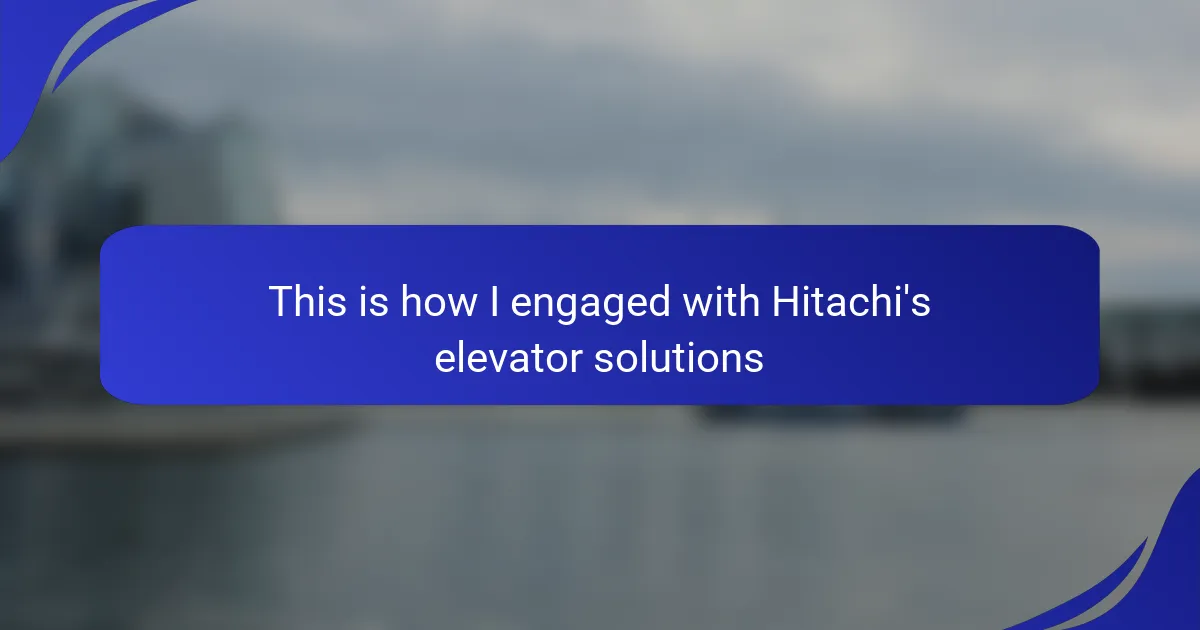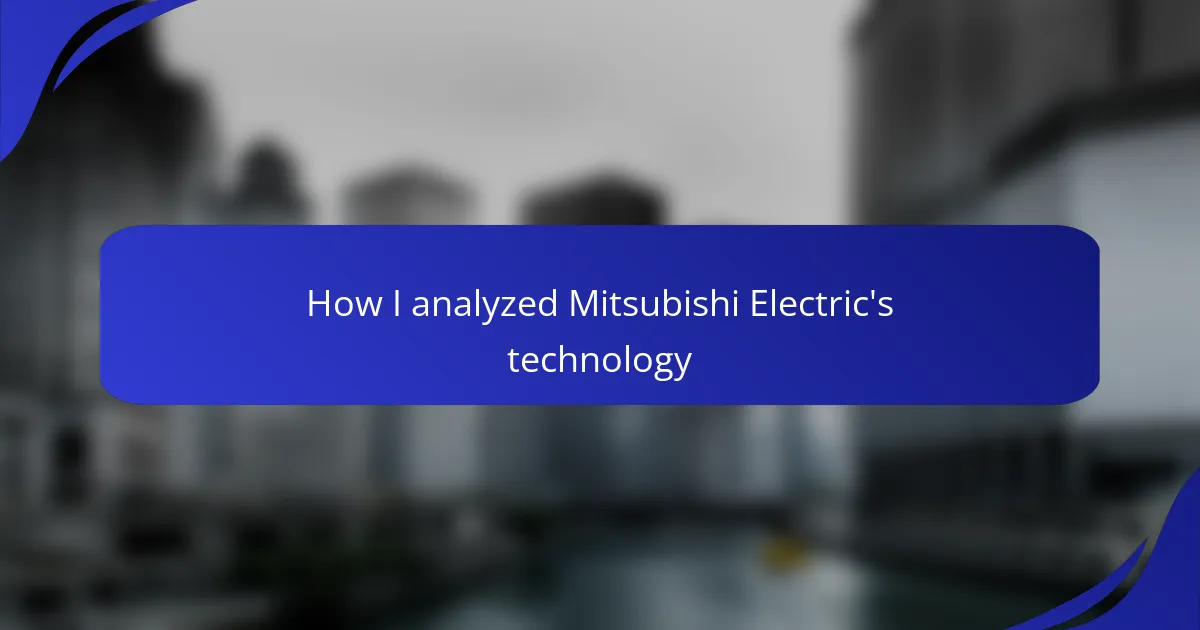Key takeaways
- The elevator industry dates back to the third century BC and saw significant advancements during the 19th century with Elisha Otis’s invention of the safety elevator.
- Key innovations from Otis Elevator include the safety brake, hydraulic elevators, and gearless traction elevators, all of which enhanced safety, efficiency, and building design.
- Otis’s impact includes the development of machine-room-less elevators and smart technology, which have transformed urban architecture and user experiences in high-rise buildings.
- Personal experiences highlight the smooth, quiet, and accessible nature of Otis elevators, emphasizing their legacy in improving vertical transportation.
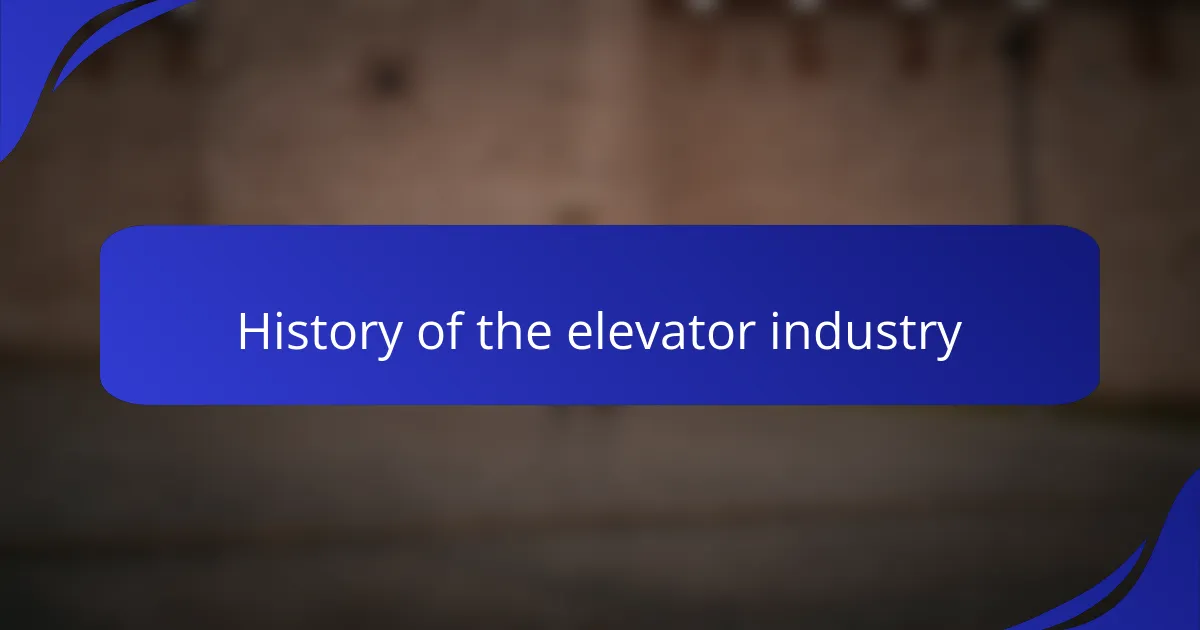
History of the elevator industry
The history of the elevator industry is a fascinating journey, beginning as early as the third century BC with simple hoisting devices. Can you imagine how gratified those early inventors must have felt when they first lifted heavy loads using basic mechanics? I often think about the ingenuity that paved the way for the complexity we see today.
Fast forward to the 19th century, when the industrial revolution brought about significant advancements. The invention of the safety elevator by Elisha Otis was a game changer. I remember reading about how he demonstrated his elevator with a daring drop test, sparking confidence in a technology that transformed urban landscapes.
By the early 20th century, elevators became essential in skyscrapers, enabling cities to stretch skyward. It’s incredible to reflect on how this shift not only changed our architecture but also how we interact with spaces. It’s amazing to think about how elevators have bridged distances, literally lifting us to new heights in both technology and society.
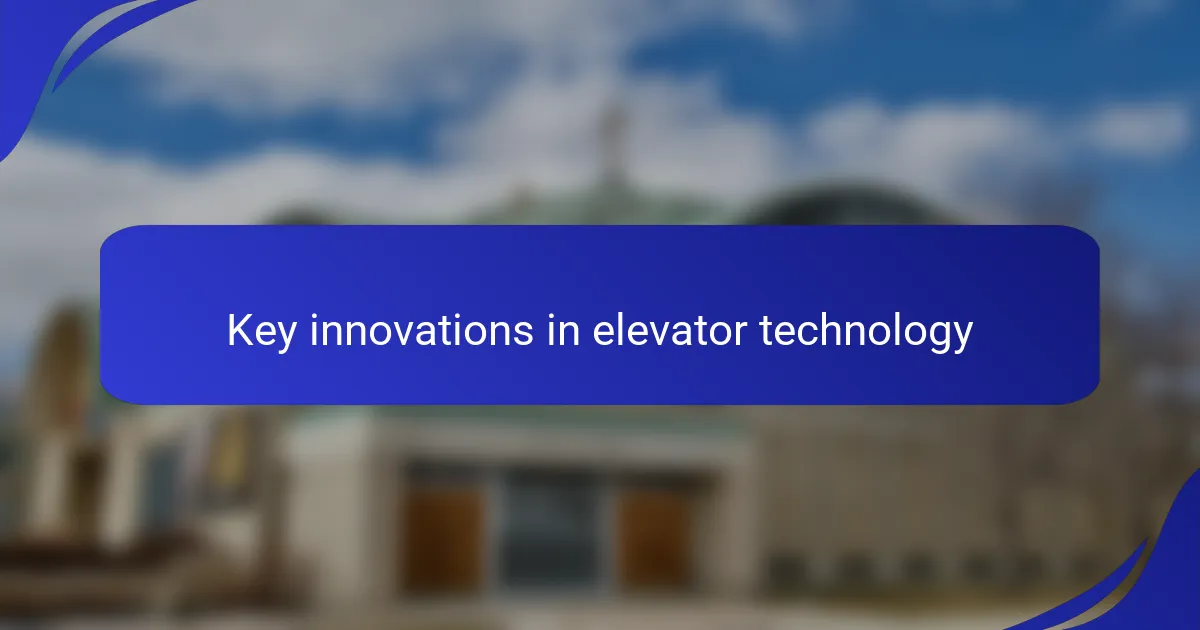
Key innovations in elevator technology
When I think about the evolution of elevator technology, Otis Elevator stands out with several groundbreaking innovations. One major leap was the development of the safety elevator in the 1850s, which utilized a safety brake system. This not only made elevators safer but fundamentally changed how buildings could be designed, allowing for taller structures.
Another significant innovation was the introduction of the hydraulic elevator, which I find remarkable. This technology allowed elevators to operate smoothly and efficiently, even in low-rise buildings, enhancing accessibility in a variety of structures. Connecting these advancements to my experience, I recall how the seamless travel of hydraulic systems truly transformed my daily routines in busy commercial buildings.
Lastly, the transition to gearless traction elevators has been revolutionary. These elevators not only provide faster speeds but also reduce energy consumption, making them an environmentally friendly option. Witnessing the difference in efficiency firsthand has made me appreciate how far Otis has taken elevator technology.
| Innovation | Description |
|---|---|
| Safety Elevator | Introduced a safety brake system that revolutionized elevator safety. |
| Hydraulic Elevator | Enabled smooth operation for low-rise buildings, enhancing accessibility. |
| Gearless Traction Elevator | Increased speed and energy efficiency, paving the way for eco-friendly elevators. |

Impact of Otis Elevator on industry
Otis Elevator has profoundly shaped the elevator industry with its pioneering innovations. I recall the first time I experienced an Otis elevator; the smoothness of the ride was astonishing, a testament to their commitment to quality. Their introduction of the safety brake not only revolutionized safety standards but also instilled a sense of confidence in users, knowing they were in a secure environment.
Furthermore, Otis’s advancements in technology have continuously raised the bar for efficiency and design in the industry. With the evolution from hydraulic systems to machine-room-less designs, I’ve seen how these innovations have transformed buildings, enabling architects to push the limits of urban design. The impact of Otis is evident in our modern skyline.
- Introduction of the safety brake, enhancing vertical transportation safety.
- Development of hydraulic elevators, making vertical transport accessible in low-rise buildings.
- Transition to machine-room-less designs, allowing for more usable building space.
- Innovations in smart elevator technology, optimizing energy efficiency and user experience.
- Global expansion, leading to standardized practices and safety measures across the industry.
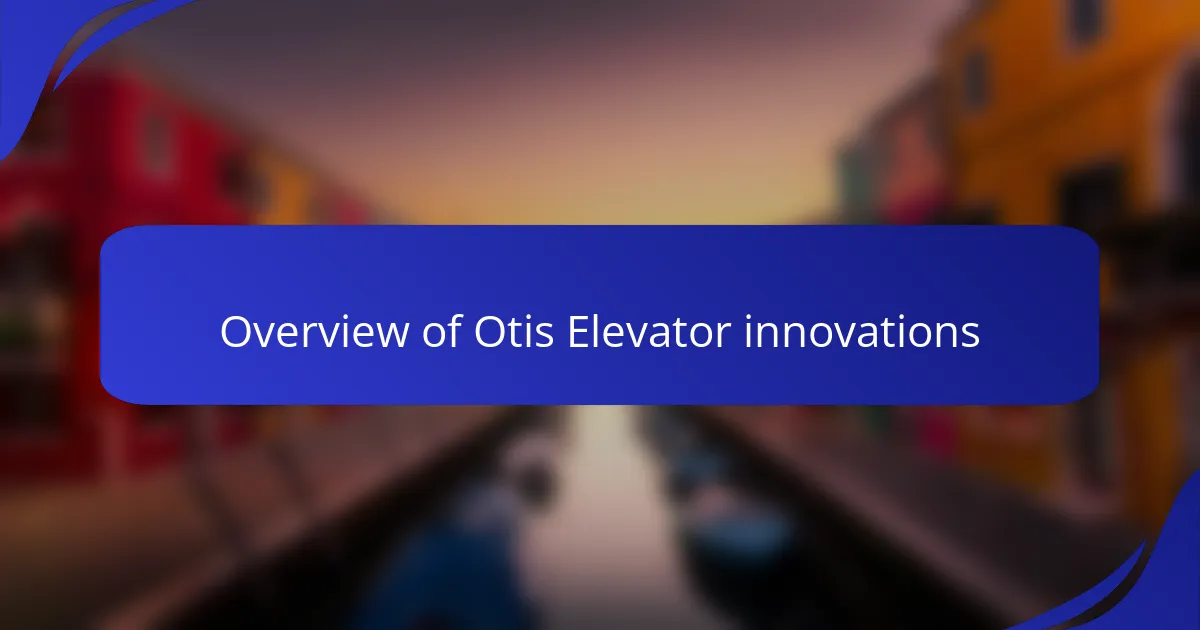
Overview of Otis Elevator innovations
Otis Elevator has long been at the forefront of innovation in the elevator industry. From the introduction of the safety elevator in the late 19th century, which revolutionized vertical transportation, to the advent of smart elevators equipped with advanced connectivity features, Otis has consistently pushed the boundaries. I’ve always admired how their innovations not only improve functionality but also enhance safety and efficiency for users.
One of the key innovations that stands out to me is the Gen2 elevator system, launched in the early 2000s. It’s fascinating how it eliminates traditional steel ropes and uses a flat, coated steel belt instead, significantly reducing maintenance needs. This kind of forward-thinking design is what keeps Otis ahead and continually reshapes our experience in high-rise buildings.
Now, let’s take a closer look at some key innovations from Otis Elevator in a comparative format:
| Innovation | Key Features |
|---|---|
| Safety Elevator (1853) | Introduced the safety mechanism that prevented free fall, setting the standard for elevator safety. |
| Gen2 (2000s) | Uses flat belt technology, reducing energy consumption and maintenance while enhancing ride quality. |
| Smart Elevators | Integration of IoT technology for predictive maintenance and improved operational efficiency. |

My first encounter with Otis Elevators
When I first stepped into an Otis elevator, I was struck by its smooth, whisper-quiet ascent. It felt like being transported seamlessly between floors, which, to be honest, was quite a revelation for me. I still remember the sensation of curiosity and excitement, captivated by the thought that this technology had been a part of city life for so long.
Reflecting on that initial experience, I appreciate the legacy Otis has built in innovation and safety. Their commitment to improving how we move in buildings has truly transformed the urban landscape, making towering structures more accessible for everyone.
| Feature | Otis Elevator |
|---|---|
| Smooth Ascent | Yes |
| Noise Level | Whisper-quiet |
| Accessibility | Highly Accessible |

Personal insights on Otis innovations
While exploring the innovations by Otis Elevator, I couldn’t help but marvel at their relentless pursuit of safety and efficiency. For instance, the introduction of the safety elevator in the late 19th century transformed the vertical transportation landscape. I remember standing in a beautifully restored historic building, feeling reassured knowing that the Otis safety brake was designed to protect passengers if something went wrong.
Another notable innovation is their machine-room-less elevators. I find it fascinating how this advancement not only saves space but also allows for cleaner architectural designs. The first time I encountered a building with this technology, it struck me how seamlessly it blended into the surroundings, showcasing a commitment to both function and aesthetics.
Here’s a comparison of some key innovations by Otis:
| Innovation | Year Introduced |
|---|---|
| Safety Elevator | 1852 |
| Machine-Room-Less Elevator | 2000 |
